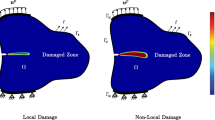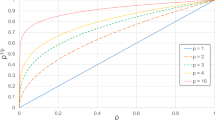Abstract
In this paper, the attainment of uniform reaction forces at the specific fixed boundary is investigated for topology optimization of continuum structures. The variance of the reaction forces at the boundary between the elastic solid and its foundation is firstly introduced as the evaluation criterion of the uniformity of the reaction forces. Then, the standard formulation of optimal topology design is improved by introducing the variance constraint of the reaction forces. Sensitivity analysis of the latter is carried out based on the adjoint method. Numerical examples are dealt with to reveal the effect of the variance constraint in comparison with solutions of standard topology optimization.













Similar content being viewed by others
References
Bendsøe MP (1989) Optimal shape design as a material distribution problem. Struct Multidisc Optim 1:193–202
Bourdin B (2001) Filters in topology optimization. Int J Numer Methods Eng 50:2143–2158
Buhl T (2002) Simultaneous topology optimization of structure and supports. Struct Multidisc Optim 23:336–346
Chang B, Shi Y, Dong S (1999) Comparative studies on stresses in weld-bonded, spot-welded and adhesive-bonded joints. J Mater Process Technol 87:230–236
Cheng GD, Guo X (1997) ε-relaxed approach in structural topology optimization. Struct Optim 13:258–266
Díaz AR, Kikuchi N (1992) Solutions to shape and topology eigenvalue optimization problems using a homogenization method. Int J Numer Methods Eng 35:1487–1502
Deaton J, Grandhi R (2013) Stiffening of restrained thermal structures via topology optimization. Struct Multidisc Optim 48:731–745
Deaton J, Grandhi R (2014) A survey of structural and multidisciplinary continuum topology optimization: post 2000. Struct Multidisc Optim 49:1–38
Duysinx P, Bendsøe MP (1998) Topology optimization of continuum structures with local stress constraints. Int J Numer Methods Eng 43:1453–1478
Fleury C, Braibant V (1986) Structural optimization: A new dual method using mixed variables. Int J Numer Methods Eng 23:409–428
Gao T, Zhang WH (2011) A mass constraint formulation for structural topology optimization with multiphase materials. Int J Numer Methods Eng 88:774–796
Hilding D (2000) A heuristic smoothing procedure for avoiding local optima in optimization of structures subject to unilateral constraints. Struct Multidisc Optim 20:29–36
Jog CS (2002) Topology design of structures subjected to periodic loading. J Sound Vib 253:687–709
Kočvara M (1997) Topology optimization with displacement constraints: a bilevel programming approach. Struct Optim 14:256–263
Kono D, Nishio S, Yamaji I, Matsubara A (2015) A method for stiffness tuning of machine tool supports considering contact stiffness. Int J Mach Tool Manu 90:50–59
Liu H, Wu J, Wang Y (2015a) Impact of anchor bolts creep relaxation on geometric accuracy decline of large computer numerical control machine tools. J Xi'an Jiaotong Univ 49:14–17
Liu H, Zhang WH, Gao T (2015b) A comparative study of dynamic analysis methods for structural topology optimization under harmonic force excitations. Struct Multidisc Optim:1–13
Ma ZD, Kikuchi N, Cheng HC (1995) Topological design for vibrating structures. Comput Methods Appl Mech Eng 121:259–280
Neves MM, Rodrigues H, Guedes JM (1995) Generalized topology design of structures with a buckling load criterion. Struct Multidisc Optim 10:71–78
Pedersen P, Pedersen N (2012) Interpolation/penalization applied for strength design of 3D thermoelastic structures. Struct Multidisc Optim 1–14
Rodrigues H, Fernandes P (1995) A material based model for topology optimization of thermoelastic structures. Int J Numer Methods Eng 38:1951–1965
Sigmund O (2001) A 99 line topology optimization code written in Matlab. Struct Multidisc Optim 21:120–127
Sigmund O, Maute K (2012) Sensitivity filtering from a continuum mechanics perspective. Struct Multidisc Optim 46:471–475
Sigmund O, Maute K (2013) Topology optimization approaches: A comparative review. Struct Multidisc Optim 48:1031–1055
Takezawa A, Nishiwaki S, Izui K (2006) Structural optimization based on topology optimization techniques using frame elements considering cross-sectional properties. Struct Multidisc Optim 34:41–60
Zhang J, Wang B, Niu F, Cheng G (2015a) Design optimization of connection section for concentrated force diffusion. Mech Based Des Struct Mach 43:209–231
Zhang WH, Yang JG, Xu YJ, Gao T (2014) Topology optimization of thermoelastic structures: mean compliance minimization or elastic strain energy minimization. Struct Multidisc Optim 49:417–429
Zhang WH, Liu H, Gao T (2015b) Topology optimization of large-scale structures subjected to stationary random excitation: An efficient optimization procedure integrating pseudo excitation method and mode acceleration method. Comput Struct 158:61–70
Zhu JH, Zhang WH, Beckers P (2009) Integrated layout design of multi-component system. Int J Numer Methods Eng 78:631–651
Zhu JH, Zhang WH, Xia L (2015) Topology optimization in aircraft and aerospace structures design. Arch Comput Method E:1–28
Zhu JH, Li Y, Zhang WH, Hou J (2016) Shape preserving design with structural topology optimization. Struct Multidisc Optim 53:893–906
Acknowledgements
This work is supported by the National Key Research and Development Program of China (2017YFB1102800), the National Natural Science Foundation of China (11672239, 11432011, 11620101002), the Natural Science Basic Research Plan in Shaanxi Province of China (2017JM1002) and the Key Research and Development Program of Shaanxi (S2017-ZDYF-ZDXM-GY-0035)
Author information
Authors and Affiliations
Corresponding authors
Appendix: Sensitivity analysis
Appendix: Sensitivity analysis
The sensitivity analysis of the global compliance and the variance of reaction forces with respect to design variables is detailed as follow.
1.1 Sensitivity analysis of the global compliance
Based on the definition of the global compliance, the sensitivity of the latter then corresponds to
In this work, the applied forces are supposed to be design-independent. This implies that
The sensitivity of the global compliance is then rewritten as
1.2 Sensitivity analysis of the variance of reaction forces
Based on the definition in Section 3, the sensitivity of the variance of the specific reaction forces corresponds to
where the partial derivative of the mean reaction force is expressed as
Thus, we have
This expression can be rewritten as
in which Λ is a vector
with each term being calculated by
To calculate \( \frac{\partial D\left(\mathbf{R}\right)}{\partial {x}_i} \), the partial derivative of the reaction force vector R is necessary. According to (6), we have
and
Under the assumption of design-independent force (i.e., \( \frac{\partial {\mathbf{F}}^{\mathrm{a}}}{\partial {x}_i}=0 \)), the above relation can be simplified as
The substitution of (A.12) into (A.10) yields
Now, the sensitivity of the variance of the considered reaction forces can be derived as
in which the adjoint method is applied to calculate the second term.
Suppose
The adjoint vector λ can then be obtained by
or
Here, \( {\mathbf{R}}_{\uplambda} \) is the reaction forces in the additional analysis related to (A.17). Obviously, only one additional finite element analysis needs to be carried out under the same boundary conditions as the original structural analysis in (2) no matter what the adjoint load is.
Thus, by virtue of the adjoint method, \( \frac{\partial D\left(\mathbf{R}\right)}{\partial {x}_i} \) is established as
In this expression, \( \frac{\partial {\mathbf{K}}_{cs}^{\mathrm{T}}}{\partial {x}_i} \) and \( \frac{\partial {\mathbf{K}}_{\mathrm{cc}}}{\partial {x}_i} \) can be easily derived at the element level.
A particular case should be mentioned herein. If the applied force is constant during optimization and the variance constraint is applied to all fixed nodes, the mean reaction force \( \overset{-}{R} \) is constant as well. As a result, the derivative of the mean reaction force with respect to all design variables in (A.5) is zero and the sensitivity of the variance of specific reaction forces in (A.4) could be simplified as
Thus, the artificial vector Λ is simplified as
Rights and permissions
About this article
Cite this article
Gao, T., Qiu, L. & Zhang, W. Topology optimization of continuum structures subjected to the variance constraint of reaction forces. Struct Multidisc Optim 56, 755–765 (2017). https://doi.org/10.1007/s00158-017-1742-0
Received:
Revised:
Accepted:
Published:
Issue Date:
DOI: https://doi.org/10.1007/s00158-017-1742-0




